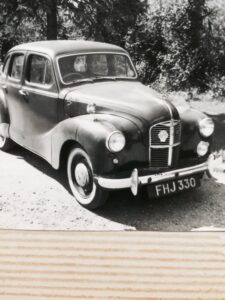
INTRODUCTION
These three motoring-related issues have been gnawing away at my equanimity for a number of years:
· Daylight driving with headlights turned on.
· Reverse parking in public car parks.
· Locating pedestrian crossings near to roundabouts.
Although any normal egotist hopes that their cri de Coeur might excite some interest, this author accepts that what follows will have minimal impact on public thinking; the only derived satisfaction will therefore be another release of steam.
DAYLIGHT DRIVING WITH HEADLIGHTS
As an avid fan of the old films on the Talking Pictures TV Channel I am constantly reminded of the halcyon driving days when few, if any, cars displayed their headlights in daylight except in very inclement conditions and even then fog lamps were the preferred option (assuming they were fitted, after all ‘back then’ wing mirrors and heaters optional extras!).
Much loved Standard 8 sans wing mirrors or heater. In the good old pre-EU days we knocked up added-value rubbish like this in return from useful goodies from the Commonwealth.
The recent enthusiasm for turning on car headlights in good/reasonable daylight visibility is mystifying since such action is both dangerous and irritating – particularly for drivers of the smaller car whose mirrors are fully occupied by the lights of 4 x 4 vehicles that determinedly tail gate prey that is low in the water line (a driving style beloved by their owners). Although the irritation of mirrors being alive with light can have dangerous consequences, it is the sudden appearance of oncoming lights over the crest of the road or round a blind bend that is really hazardous. Whereas, at night, there is some warning of oncoming lights, by day there is none, resulting in complete surprise to oncoming traffic.
As for driving on Dual Carriageways and Motorways the stress of facing mile after mile of oncoming headlights has a deleterious impact on both temper and concentration. Bearing in mind there is no oncoming traffic on the friendly forces side of on such arterial routes, what is the point in turning on headlights?
There has recently been much correspondence in the Daily Telegraph about the blinding impact of the modern LED headlight and as far back as 2013 the RAC raised the issue but a change of thinking seems to elude the decision-makers. At the risk of straying from the main point of this tirade, it might also be observed that the hazards have grown as manufacturers compete for the introduction of garish wrap around tail lights and illuminated gargantuan wing mirrors. I would defy anyone trailing a new Volvo for mile after mile not to lose the will to live.
While the introduction of the LED lights means that the impact on fuel consumption is only minimal it might be observed that people who drive during the daytime with their older incandescent headlights on are reducing their mpg significantly. So, fuel consumption and light pollution are also factors to be borne in mind in this debate rant.
The concluding question is surely: What is the benefit of deploying car headlights during daylight? It is recognized that some studies have suggested that there are some improvements in safety but I am not convinced, bearing in mind the increased stress on drivers on our ever more crowded roads. If the underlying reason for using lights during the day is to be seen by oncoming traffic, could we not:
· Simply use side lights.
· Recommend drivers cars of colours that are known to be more easily seen.
· Adopt Lord Mountbatten’s idea of mounting headlights on gimbals.
REVERSE PARKING
In an age when many cars have almost out-grown parking spaces, why is it that so many drivers opt to reverse into a confined space? Our local Supermarket is too often blocked by Chelsea Tractors toing and froing into a narrow parking slot. It is surely speedier and easier to occupy a narrow space going forwards and subsequently to reverse into the relatively wide open space of the car park? For the older driver, reversing becomes more of a challenge which, as a very OAP, may be my reason for raising this matter.
LOCATION OF PEDESTRIAN CROSSINGS
I am not sure who the geniuses are that determine the location of pedestrian crossings but, whoever they are, perhaps they should ask themselves this: Why is that so many pedestrian crossings are located within a few yards of a roundabout? One does not need to be a traffic management expert to know that pedestrian crossings so located create regular traffic jams on a roundabout. As for the distraction, and cost to taxpayers, of the now fashionable LGBQT pedestrian crossings, I make no comment.

Leave a Reply
You must be logged in to post a comment.